This story was produced as part of the nine-part series “Are We Ready? How Schools Are Preparing – and Not Preparing – Children for Climate Change,” reported by HuffPost and The Hechinger Report, a nonprofit, independent news organization focused on inequality and innovation in education.

CHAUVIN, La. — Izzy Allen, 13, has watched gas stations and grocery stores close. She’s seen vines grow over abandoned homes while other houses have been lifted on stilts, ten or fifteen feet off the ground. She remembers that her father, a shrimper, used to have to inch his boat carefully away from the dock behind their house so as not to hit the bayou’s narrow banks. The land has disappeared at such a rapid clip that he can pull it out easily now, even when another boat is passing behind his.
Are We Ready?
This nine-part series explores how we’re teaching through climate change. We report on how climate change emergencies are disrupting student learning, exacerbating mental health problems, devastating school infrastructure, and how the coronavirus pandemic is a preview of what education looks like in a climate emergency. We also look at how textbooks are coming up short in teaching kids about climate, how medical schools are preparing future doctors, and how despite the obstacles some educators are finding ways to give students skills they need to better protect themselves and their communities.
The eighth grader can also remember each of the kids she began school with back at Boudreaux Canal Elementary School. “All the teachers, all the kids, knew everybody’s name,” she recalled on a recent Friday afternoon. But that school closed after she finished first grade in 2013, a victim of declining enrollment after relentless flooding and job losses drove families from the area. The elementary she went to next, Upper Little Caillou, had replaced another nearby school that had shuttered for the same reasons a few years earlier.

Lacache Middle School, which Izzy currently attends, sits along the bayou on one of the lowest-lying tips of Louisiana’s Terrebonne Parish. Every year, she loses classmates who move farther inland or to Texas. It’s a scenario playing out across coastal Louisiana and in other areas of the country vulnerable to floods and storms that are worsening because of climate change.
As sea level rise drives more and more to people seek higher ground — a phenomenon sometimes known as “climate migration” — those who remain will be increasingly left to make do with less. Hampered by school funding formulas based on property tax dollars and student enrollment, these schools are already being forced to cut teaching positions and scrimp on materials and technology. Schools farther inland, meanwhile, are under pressure to accommodate arriving students — forced to increase class sizes and provide support for transient students who lose learning time with each move.
With at least 6,444 schools serving almost 4 million students located in parts of the country at high risk of flooding, it’s a set of challenges that’s only going to become more common. At Lacache, the question is already pressing: When families start leaving the areas on the front lines of climate change, what kind of education — and future — remains for those who stay?
Like many of her students at Lacache, English teacher Summer Skarke can trace her family here back generations. One winter Friday inside her classroom in the two-story brick school building, Skarke was facilitating a discussion with her eighth-grade students about the short story “The Lady, or the Tiger?” — an allegory about making a difficult decision between two unknowns. In Skarke’s bright, colorful classroom, students who couldn’t find a place at one of the crowded desks sat instead on chairs clustered in a corner. Skarke let one student work at her own desk while she walked around the room, checking students’ work and giving out heart-shaped cookies to celebrate Valentine’s Day.
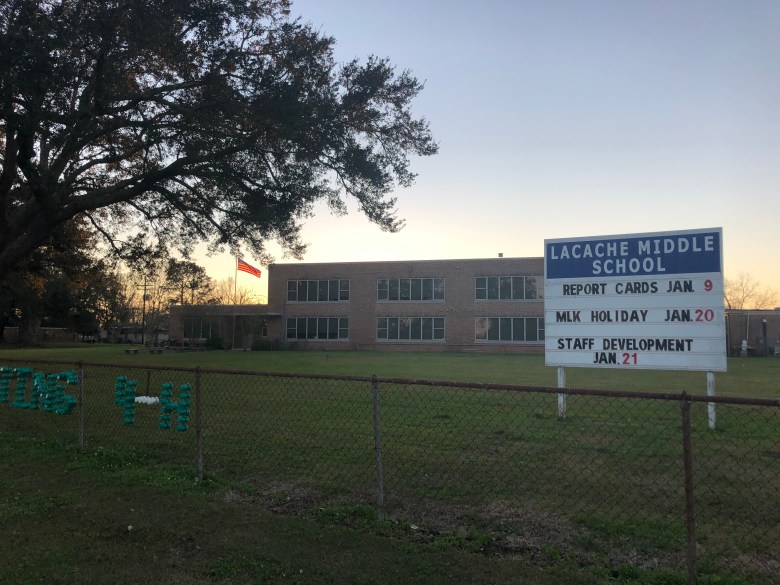
Since Skarke began teaching at Lacache in 1999, the number of students has fallen by almost a quarter to 387. But the number of teachers has declined more precipitously, she said. There are three eighth-grade teachers today, compared to eight when she started, and the vast majority of classrooms now have more than 21 students.
“You have more kids in a class with less teachers, and you have teachers teaching subjects that they’re not 100 percent at,” said Skarke. Teachers double up on subjects — one of her colleagues teaches social studies and science in one 90-minute block.
Teachers and administrators are having to scrimp because fewer students means less per-pupil funding ($9,420 per student in Terrebonne Parish). Losing four or five students can make a dent in the budget equivalent to one teacher’s salary. School enrollment in the Parish has dropped from more than 19,000 in 2008 to around 17,200 early this year. And yet, as school administrators are quick to point out, most costs remain the same. “If you have a school bus going down street A picking up 50 kids, and 25 kids move, you still have that same school bus, but just picking up 25 kids,” explained Philip Martin, superintendent of Terrebonne Parish schools. “It’s resulted in a much more challenging financial environment for us.”
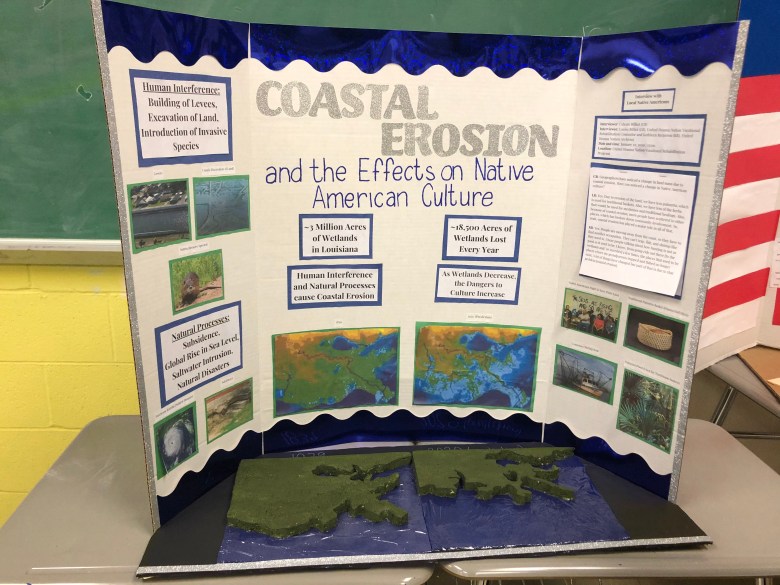
Such financial challenges threaten schools when their populations are at their highest need. Allison Plyer, chief demographer at The Data Center, a New Orleans-based research organization, noted that climate migration tends to leave the poor behind. “The poor often don’t have the resources to be able to leave. They don’t have extended social networks, family and friends, that can help them resettle elsewhere,” Plyer said. “They don’t have money in the bank, and moving costs money. When middle-income people leave, they often take a loss on their house — that’s a choice they can make.” It’s a choice fewer and fewer people in the parish can afford to make. The number of people receiving food stamp benefits grew in Terrebonne Parish from less than 15,000 in 2007 to 23,000 in 2017.
Related: The silence of school teachers on climate change
The decline of the area’s industries is a big factor, too. The BP oil spill in 2010 brought the seafood industry, already flagging due to coastal erosion, to a near standstill. The area has lost thousands more jobs since mid-2014, when plummeting oil prices sparked layoffs. Since the bust began, nearly one of every four people in the labor force have left Terrebonne and Lafourche or stopped looking for work, according to a Houma Today analysis of data from the Louisiana Workforce Commission.
At Lacache, “what you have left over is a very poverty-stricken population,” said Principal Mark Thibodeaux. “You don’t have a lot of affluent families living out here anymore, they’ve all moved further north.”
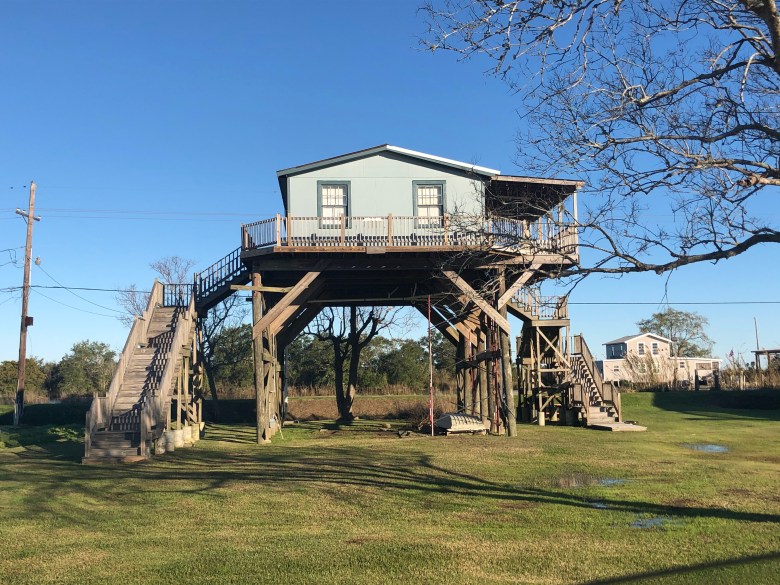
The heightened concentration of poverty has made it challenging to teach, said computer lab instructor Simonne Lanigan, as a group of students lingered to get a last few minutes of screen time in the lab while bus numbers were called over the loudspeaker.
“They’re coming from a place where they’re trying to survive, and I’m asking them to learn, and ‘Hey you’re going to go to college’ and all that,” she said. But circumstances prevent many from learning. “(T)hey need to sleep in class because they didn’t sleep at home, or (they) come to school to eat,” she said. Lanigan increasingly sees her students living with extended family, doubled up in cramped homes. At fundraisers, the school can barely eke out a few thousand dollars from cash-strapped parents, she said.
As schools have retreated from the coast, Lanigan has moved up the bayou with them. She started at Little Caillou and remembers spending days after each storm cleaning out her flood-soaked classroom. She moved with her students to Boudreaux Canal after four destructive hurricanes in a row finally shut that school down. So she wasn’t surprised when Boudreaux Canal closed, too.
Boudreaux’s one-story white wooden building still stands empty along a boat-lined canal that drains into the Gulf just a few miles south. It closed in 2013 when the enrollment dropped from 127 to 87 within five years. “People (are) trying to not live much in the low-lying areas for several reasons: flooding, the potential hurricane damage, and the high cost of insurance to live there. It’s really just not financially feasible to run a school for just 87 kids,” said Martin, the district superintendent.
Students who’ve remained in communities down the bayou often struggle to keep up when flooded roads keep them out of school for days at a time. “Whether or not they’re able to make all of it up depends on how long they’re out,” said Darrell Dillard, principal at Ellender Memorial High School. The school is in Houma, the southernmost city in Terrebonne, where the swollen bayous — the five fingers, as people call them — converge. “I do see an effect. They’re losing time, instructional time.”
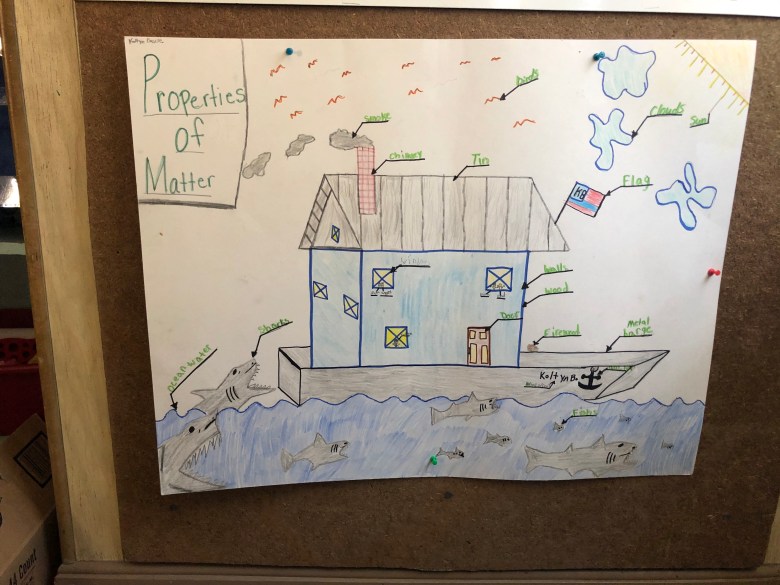
The emerging cycle of population loss, economic strain and collapsing services prompted the state last year to suggest in its regional adaptation strategy that bolder steps might be necessary. “(The state) cannot continue to rebuild in place and in replication of what previously existed,” planners wrote. In some parts of the state, schools are becoming the first to enact the plan.
Related: How Louisiana’s richest students go to college on the backs of the poor
Around the country, school funding formulas tied to property taxes and enrollment threaten to exacerbate the challenges of disaster-hit communities. “It’s going to be sort of a spiral because the fewer schools, the less attractive it’s going to be to families and there will be less ability to even do the infrastructure to do any decent adaption or hazard mitigation,” said Patrick Marchman, a hazard mitigation planner for Michael Baker International, an engineering consulting firm. “When you fund things in the tax structures that we have right now, this is what’s going to happen. It’s one of those things that our systems are not super well designed to handle.”
Some states have created stopgap measures to help. In California, Governor Gavin Newsom signed a budget bill in 2019 that allocated money to “backfill” property tax losses in communities affected by wildfires. Other states, like Iowa and Texas, have granted schools experiencing enrollment declines a grace year before funding follows suit. After that, though, many school districts are on their own.
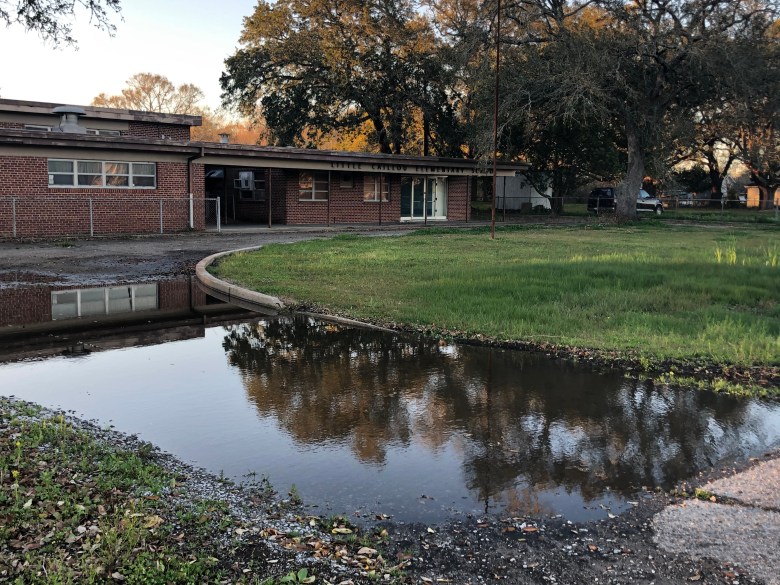
Mike Wells, superintendent of the Hamburg Community School District, in Iowa, and principal of the district’s K-8 school, saw the enrollment of his school drop from 227 to 199 students in the 2019-20 school year, the first year after historic flooding submerged the area. Next year, his district will lose $200,000 in funding, forcing him to reduce staffing and possibly combine classes. “That second year, you drop off a cliff,” he said. “The state has no solutions that really help us.”
Superintendent Bill Husfelt of Bay District Schools, in Panama City, Florida, has been fighting to get more money from the state. The district received $12 million in state money after Hurricane Michael devastated the area in 2018, shrinking the student population by about 10 percent. But Husfelt said that money won’t solve the district’s problems: So much property was destroyed in the storm that the tax base has eroded and people have nowhere to live. Husfelt was forced to close or consolidate five schools.
These trends demand forward-thinking planning that communities are so far failing to do, argued Rachel Cleetus, policy director with the climate and energy program at the Union of Concerned Scientists. “People in some cases will have to be on the move and we need to be investing in where they’ll go — making sure there are jobs and schools and all the infrastructure that’s needed,” she said. “If we don’t invest ahead of time in receiving communities, you’ll get a backlash.”
Related: Teaching global warming in a charged political climate
In Terrebonne Parish, school administrators said that an empty site the district recently purchased farther up the bayou could house a new school building if the current trends continue. “In the long range of things, I think we’re going to continue to have a population shift to higher elevation,” said Jack Moore, Terrebonne Parish school district’s risk manager. “If it goes far enough, we’ll abandon more schools — those that were subject to flooding, and the population leaves.”But it’s not something anyone wants to talk about. “If you speak to anyone in those communities, the last thing they want to see leave is their school,” said Moore.
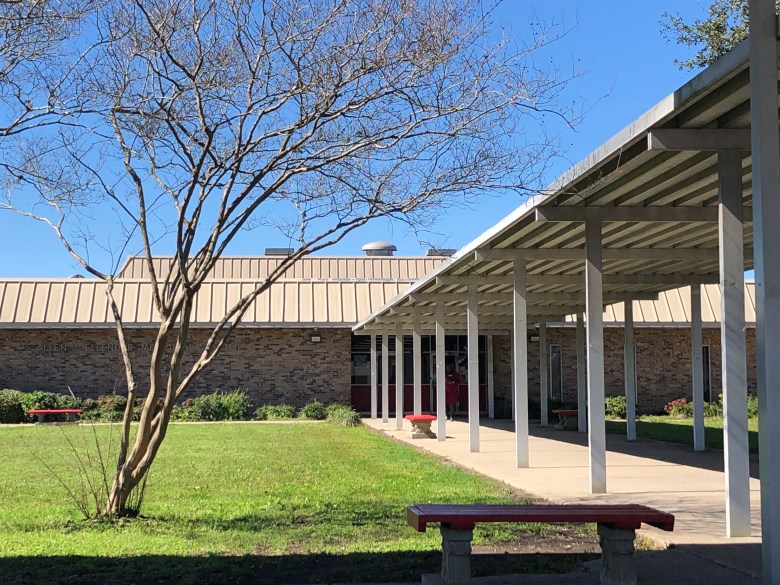
In rural areas like Terrebonne, he noted, generations of families pass through a school’s halls. Schools don’t just serve to educate students; they are often the only community center. And the population effects, Moore said, cut both ways. “(It’s) almost like a death spiral: Once you lose your school, you lose your population as well,” he said.
Izzy, the Lacache Middle School student, worries about this, too. She wants to be able to live here and to watch her younger cousins pass through Lacache’s halls, too. For a recent school project, Izzy and some of her classmates designed a robot that would move sandbags to help protect the coast from storms. She spent time looking at maps of coastal projections and was terrified to see how much more land the parish could lose by 2050. “We’re only graduating in 2024. So, it’s like half of our life that we’re not going to be able to live down here,” she said. “It feels kind of sad. Once you get here, you’re basically attached. It’s hard for us to leave.”



